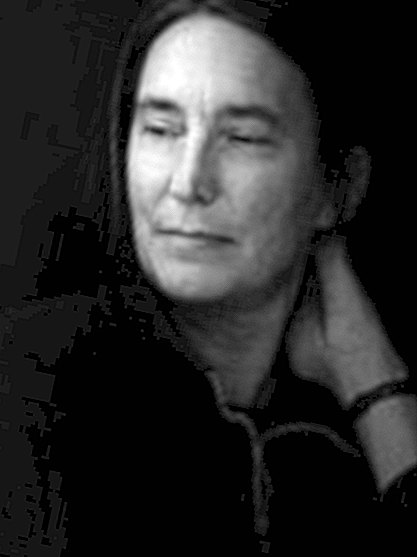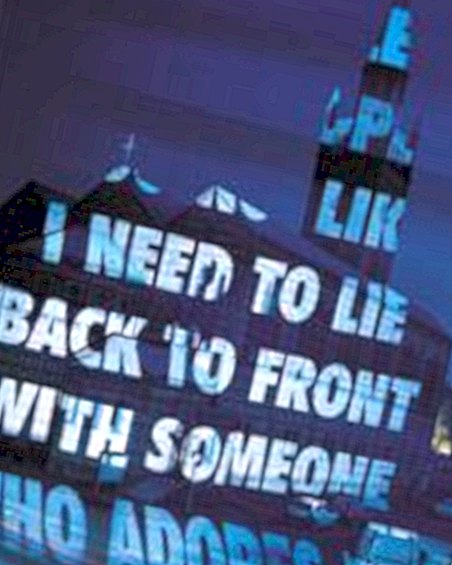The art with the word

She presents herself as a great pessimist. She needs her pessimism, that's the only way to keep her alive, Jenny Holzer has often said. She never explained that. Maybe she needs him to be creative. Then he has to be a strong power spring. The narrow woman of nearly 60 years works like an addict with her favorite materials: with words and with light. Perhaps her pessimism also shatters her worries about the world that appear in her work: power and oppression, poverty and exploitation, torture and war - her issues are one challenge.

It was always about the big connections. Already as a child in Ohio, she did not just paint trees or houses, but wanted to portray the history of the world on a long roll of paper: "Bizarrely, I painted the Noah's Ark and immediately behind it the invention of the car," she says. That may have been because her father was a car dealer. The mother worked as a riding teacher. Later, when Jenny Holzer was already an abstract artist living in New York, she pushed her limits with colors and canvas. "I failed to convey my concerns," she says. "I could never paint as well as Gerhard Richter, for example." Maybe that makes her such a productive pessimist: that she is also a great realist. In retrospect, it seems a stroke of luck that she believed she was not good enough as a painter. So she brought the text into her pictures to transport the contents - and gave the art a new dimension.
Text art for the public space
Jenny Holzer began in 1977 with sentences she called "Truisms", "truisms": "Ambivalence can destroy your life" or "Your oldest fears are the worst" - or your personal statement: "Protect me from what I want." Protect me in front of what I want. She printed her texts on posters and t-shirts and placarded them in the streets of New York.
Since then, her art has always remained in public space. But it changed, gained in shape and radiance. Soon, Jenny Holzer went on to run her texts on LED panels, display panels with LEDs, later on projectors. They wandered over the façade of the chancellery in Berlin at night and reflected in the lagoon of Venice. They meandered up the rotunda of the Guggenheim Museum in New York and raced over the ceiling beams of Berlin's Neue Nationalgalerie.
Their art seems compatible with any place, nestles on every building. So she has become a popular artist for memorials and monuments. She has been a frequent guest at major art events such as the Documenta for years and in 1990 was the first woman to design the American Pavilion at the Venice Biennale - and immediately won the Golden Lion.
Jenny Holzer's text images already have an emotional power before they are read. And go even deeper, if you have read them.

Sometimes the artist hides near her works and watches people as they pass by stop, stop, and then begin to read. The reactions of her audience are part of her art. And never were they so fierce as in the project that is still the most important to her today: "Lustmord" (1993). For the first time, her texts referred to a specific event: the war in the former Yugoslavia and the systematic rape there. She has never been so relentless in text and form. For the pictures she wrote phrases on the skin of women. "With you in me I begin to suspect death" was one of them. She said afterwards that she was crying while she was writing this. She was not an accomplished writer, she could only make such sentences by letting herself completely fall into such a theme in her thoughts and feelings. So it's self-protection that she barely writes herself today. She finds her material in the meantime with other authors. She gets a lot out of the books of the poet Henri Cole - or directly from his thoughts. The two have known each other for ten years when they were scholarship holders of the American Academy in Berlin. Through him her head has more rest and can concentrate more on the shape.
Your child is the most important thing in life
Her life has been a haven of peace for decades: the artist Mike Glier. The two met in their mid 20s, were co-founders of the artist group Colab, have exhibited a lot together. The big career has only been done by them. Their daughter Lilli is 21. For a long time, Jenny Holzer has been in the habit of putting a child into this world, saying that no child would be the end of humanity, saying, "The squirrels finally have their rest." Through such phrases flashes her humor that everyone swarms with, with whom she works. And that does not make her sound as negative as she always describes herself.Lilli is the only thing Jenny Holzer has ever called the most important thing in her life. Of course her work.
In her current project she works with autopsy reports and interrogation protocols, formerly secret documents of the American war on terror. "Waterboarding", the method of torture that simulates drowning, is a particular concern. She finds it impossible to find an expression for this interrogation practice, she says. And yet it tries, with its light panels and huge silkscreen prints, on which individual details or entire blocks are blackened. If she's free to ask for a project, she says, "I'll take a look at what beauty queens often say: 'I want peace for the world, I need to heal AIDS, I'll save the polar bears and the whales and the hummingbirds, and I want freedom for every soul. '"So hopelessly optimistic can only sound like an incorrigible pessimist.
The big Jenny-Holzer show
At the Fondation Beyeler near Basel, works from different phases of Jenny Holzer are currently on show - some of them for the first time in Europe: her Truisms, her LED installations, but above all her recent paintings and installations. Until January 24, 2010; www.beyeler.com.










